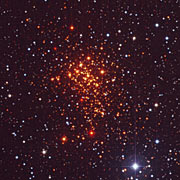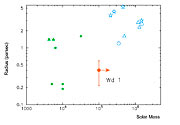Press Release
Young and Exotic Stellar Zoo
ESO's Telescopes Uncover Super Star Cluster in the Milky Way
22 March 2005
Super star clusters are groups of hundreds of thousands of very young stars packed into an unbelievably small volume. They represent the most extreme environments in which stars and planets can form. Until now, super star clusters were only known to exist very far away, mostly in pairs or groups of interacting galaxies. Now, however, a team of European astronomers [1] have used ESO's telescopes to uncover such a monster object within our own Galaxy, the Milky Way, almost, but not quite, in our own backyard! The newly found massive structure is hidden behind a large cloud of dust and gas and this is why it took so long to unveil its true nature. It is known as "Westerlund 1" and is a thousand times closer than any other super star cluster known so far. It is close enough that astronomers may now probe its structure in some detail. Westerlund 1 contains hundreds of very massive stars, some shining with a brilliance of almost one million suns and some two-thousand times larger than the Sun (as large as the orbit of Saturn)! Indeed, if the Sun were located at the heart of this remarkable cluster, our sky would be full of hundreds of stars as bright as the full Moon. Westerlund 1 is a most unique natural laboratory for the study of extreme stellar physics, helping astronomers to find out how the most massive stars in our Galaxy live and die. From their observations, the astronomers conclude that this extreme cluster most probably contains no less than 100,000 times the mass of the Sun, and all of its stars are located within a region less than 6 light-years across. Westerlund 1 thus appears to be the most massive compact young cluster yet identified in the Milky Way Galaxy.
Super Star Clusters
Stars are generally born in small groups, mostly in so-called "open clusters" that typically contain a few hundred stars. From a wide range of observations, astronomers infer that the Sun itself was born in one such cluster, some 4,500 million years ago.
In some active ("starburst") galaxies, scientists have observed violent episodes of star formation, leading to the development of super star clusters, each containing several million stars.
Such events were obviously common during the Milky Way's childhood, more than 12,000 million years ago: the many galactic globular clusters - which are nearly as old as our Galaxy - are indeed thought to be the remnants of early super star clusters.
All super star clusters so far observed in starburst galaxies are very distant. It is not possible to distinguish their individual stars, even with the most advanced technology. This dramatically complicates their study and astronomers have therefore long been eager to find such clusters in our neighbourhood in order to probe their structure in much more detail.
Now, a team of European astronomers [1] has finally succeeded in doing so, using several of ESO's telescopes at the La Silla observatory (Chile).
Westerlund 1
The open cluster Westerlund 1 is located in the Southern constellation Ara (the Altar). It was discovered in 1961 from Australia by Swedish astronomer Bengt Westerlund, who later moved from there to become ESO Director in Chile (1970 - 74). This cluster is behind a huge interstellar cloud of gas and dust, which blocks most of its visible light. The dimming factor is more than 100,000 - and this is why it has taken so long to uncover the true nature of this particular cluster.
In 2001, the team of astronomers identified more than a dozen extremely hot and peculiar massive stars in the cluster, so-called "Wolf-Rayet" stars. They have since studied Westerlund 1 extensively with various ESO telescopes.
They used images from the Wide Field Imager (WFI) attached to the 2.2-m ESO/MPG as well as from the SUperb Seeing Imager 2 (SuSI2) camera on the ESO 3.5-m New Technology Telescope (NTT). From these observations, they were able to identify about 200 cluster member stars.
To establish the true nature of these stars, the astronomers then performed spectroscopic observations of about one quarter of them. For this, they used the Boller & Chivens spectrograph on the ESO 1.52-m telescope and the ESO Multi-Mode Instrument (EMMI) on the NTT.
An Exotic Zoo
These observations have revealed a large population of very bright and massive, quite extreme stars. Some would fill the solar system space within the orbit of Saturn (about 2,000 times larger than the Sun!), others are as bright as a million Suns.
Westerlund 1 is obviously a fantastic stellar zoo, with a most exotic population and a true astronomical bonanza. All stars identified are evolved and very massive, spanning the full range of stellar oddities from Wolf-Rayet stars, OB supergiants, Yellow Hypergiants (nearly as bright as a million Suns) and Luminous Blue Variables.
All stars so far analysed in Westerlund 1 weigh at least 30-40 times more than the Sun. Because such stars have a rather short life - astronomically speaking - Westerlund 1 must be very young. The astronomers determine an age somewhere between 3.5 and 5 million years. So, Westerlund 1 is clearly a "newborn" cluster in our Galaxy!
The Most Massive Cluster
Westerlund 1 is incredibly rich in monster stars - just as one example, it contains as many Yellow Hypergiants as were hitherto known in the entire Milky Way!
"If the Sun were located at the heart of Westerlund 1, the sky would be full of stars, many of them brighter than the full Moon", comments Ignacio Negueruela of the Universidad de Alicante in Spain and member of the team.
The large quantity of very massive stars implies that Westerlund 1 must contain a huge number of stars. "In our Galaxy, explains Simon Clark of the University College London (UK) and one of the authors of this study, "there are more than 100 solar-like stars for every star weighing 10 times as much as the Sun. The fact that we see hundreds of massive stars in Westerlund 1 means that it probably contains close to half a million stars, but most of these are not bright enough to peer through the obscuring cloud of gas and dust". This is ten times more than any other known young clusterin the Milky Way.
Westerlund 1 is presumably much more massive than the dense clusters of heavy stars present in the central region of our Galaxy, like the Arches and Quintuplet clusters. Further deep infrared observations will be required to confirm this.
This super star cluster now provides astronomers with a unique perspective towards one of the most extreme environments in the Universe. Westerlund 1 will certainly provide new opportunities in the long-standing quest for more and finer details about how stars, and especially massive ones, do form.
... and the Most Dense
The large number of stars in Westerlund 1 was not the only surprise awaiting Clark and his colleagues. From their observations, the team members also found that all these stars are packed into an amazingly small volume of space, indeed less than 6 light-years across. In fact, this is more or less comparable to the 4 light-year distance to the star nearest to the Sun, Proxima Centauri!
It is incredible: the concentration in Westerlund 1 is so high that the mean separation between stars is quite similar to the extent of the Solar System.
"With so many stars in such a small volume, some of them may collide", envisages Simon Clark. "This could lead to the formation of an intermediate-mass black hole more massive than 100 solar masses. It may well be that such a monster has already formed at the core of Westerlund 1."
The huge population of massive stars in Westerlund 1 suggests that it will have a very significant impact on its surroundings. The cluster contains so many massive stars that in a time span of less than 40 million years, it will be the site of more than 1,500 supernovae. A gigantic firework that may drive a fountain of galactic material!
Because Westerlund 1 is at a distance of only about 10,000 light-years, high-resolution cameras such as NAOS/CONICA on ESO's Very Large Telescope can resolve its individual stars. Such observations are now starting to reveal smaller stars in Westerlund 1, including some that are less massive than the Sun. Astronomers will thus soon be able to study this exotic galactic zoo in great depth.
Notes
[1] The team is composed of Simon Clark (University College London, UK), Ignacio Negueruela (Universidad de Alicante, Spain), Paul Crowther (University of Sheffield, UK), Simon Goodwin (University of Wales, Cardiff, UK), Rens Waters (University of Amsterdam) and Sean Dougherty (Dominion Radio Astrophysical Observatory).
More information
The research presented in this ESO Press Release will soon appear in the leading research journal Astronomy and Astrophysics ("On the massive stellar population of the Super Star Cluster Westerlund 1" by J.S. Clark and colleagues). The PDF file is available at the A&A web site. A second paper ("Further Wolf-Rayet stars in the starburst cluster Westerlund 1", by Ignacio Negueruela and Simon Clark) will also soon be published in Astronomy and Astrophysics. It is available as astro-ph/0503303.
A Spanish press release issued by Universidad de Alicante is available on the web site of Ignacio Negueruela.
Contacts
Ignacio Negueruela
Universidad de Alicante
Alicante, Spain
Tel: +34 965 903400 ext 2441
Email: ignacio@dfists.ua.es
Simon Clark
University College London,
London, UK
Tel: +44 207 679 4372
Email: jsc@star.ucl.ac.uk
About the Release
| Release No.: | eso0510 |
| Legacy ID: | PR 08/05 |
| Name: | Westerlund 1 |
| Type: | Local Universe : Star : Grouping : Cluster |
| Facility: | ESO 1.52-metre telescope, MPG/ESO 2.2-metre telescope, New Technology Telescope |
| Instruments: | EMMI, SUSI2 |
| Science data: | 2005A&A...436..541N 2005A&A...434..949C |


